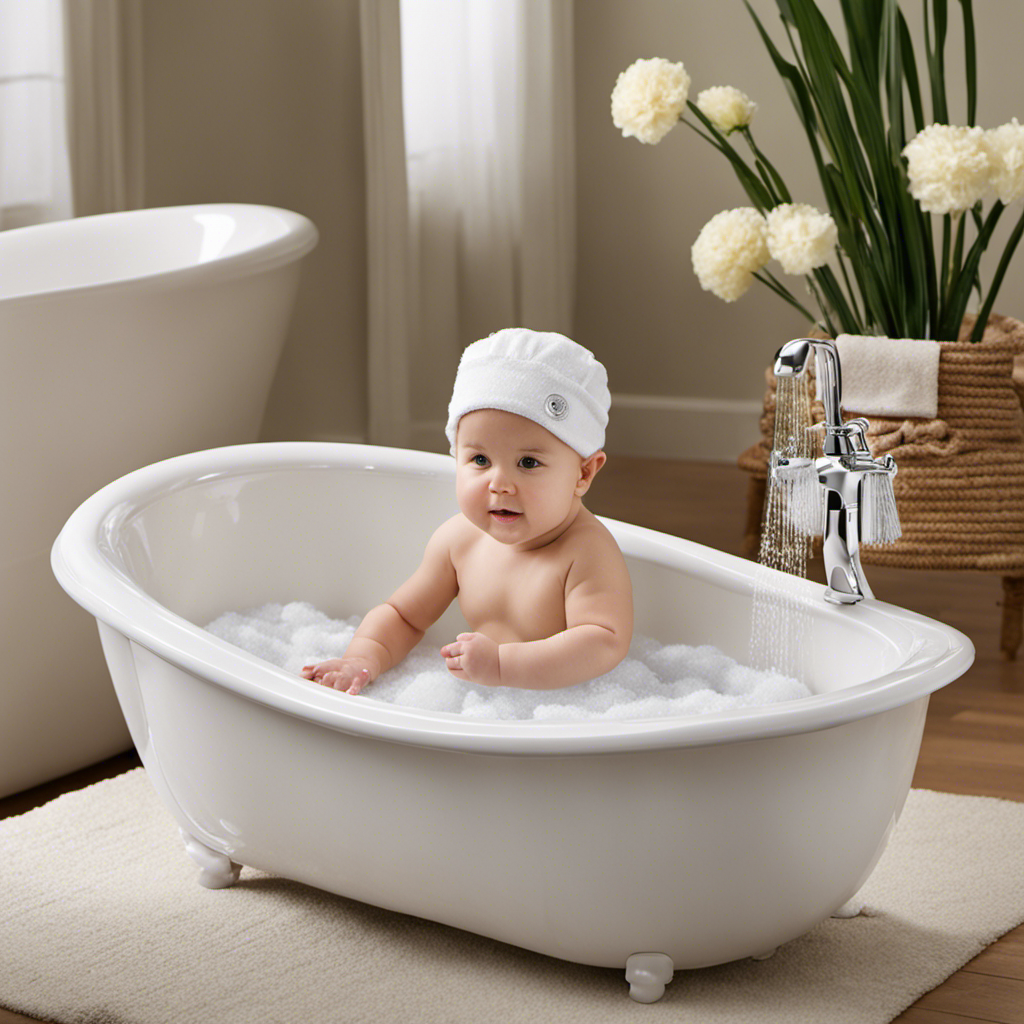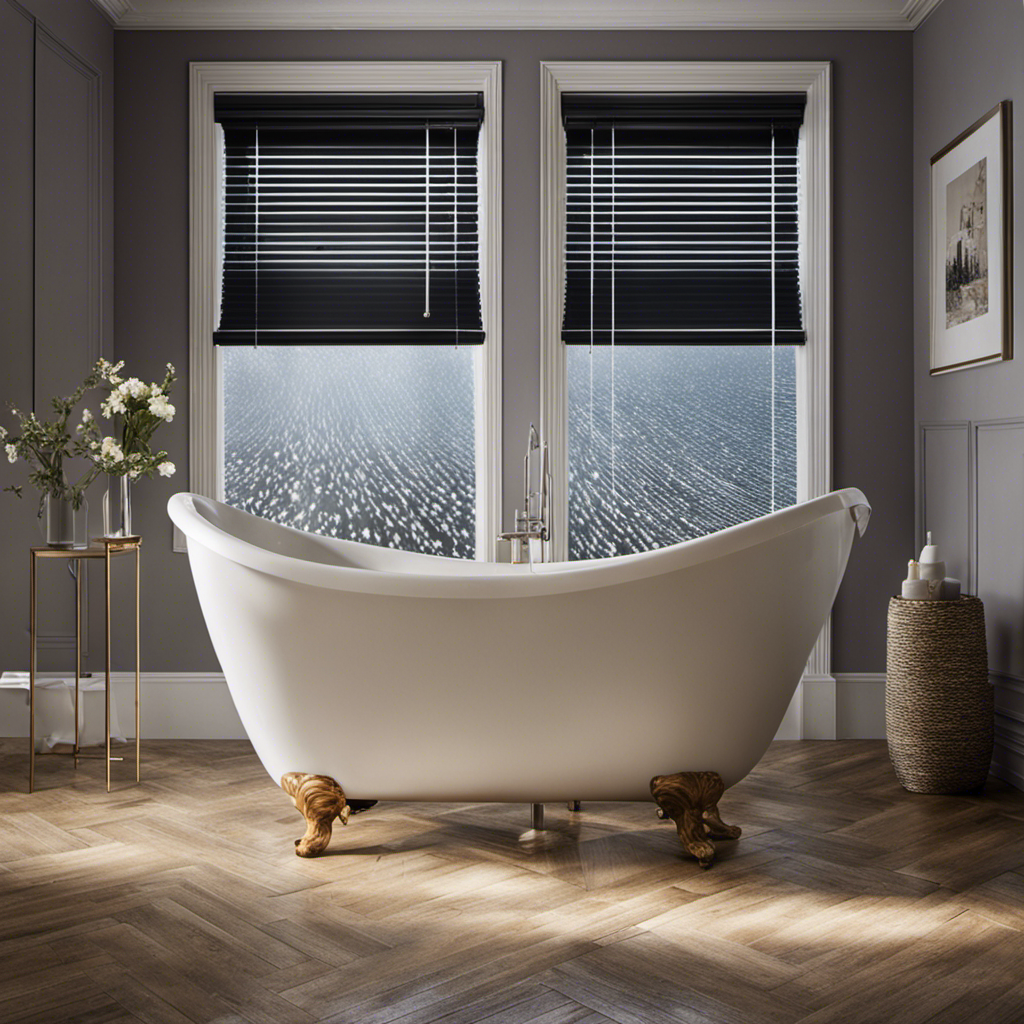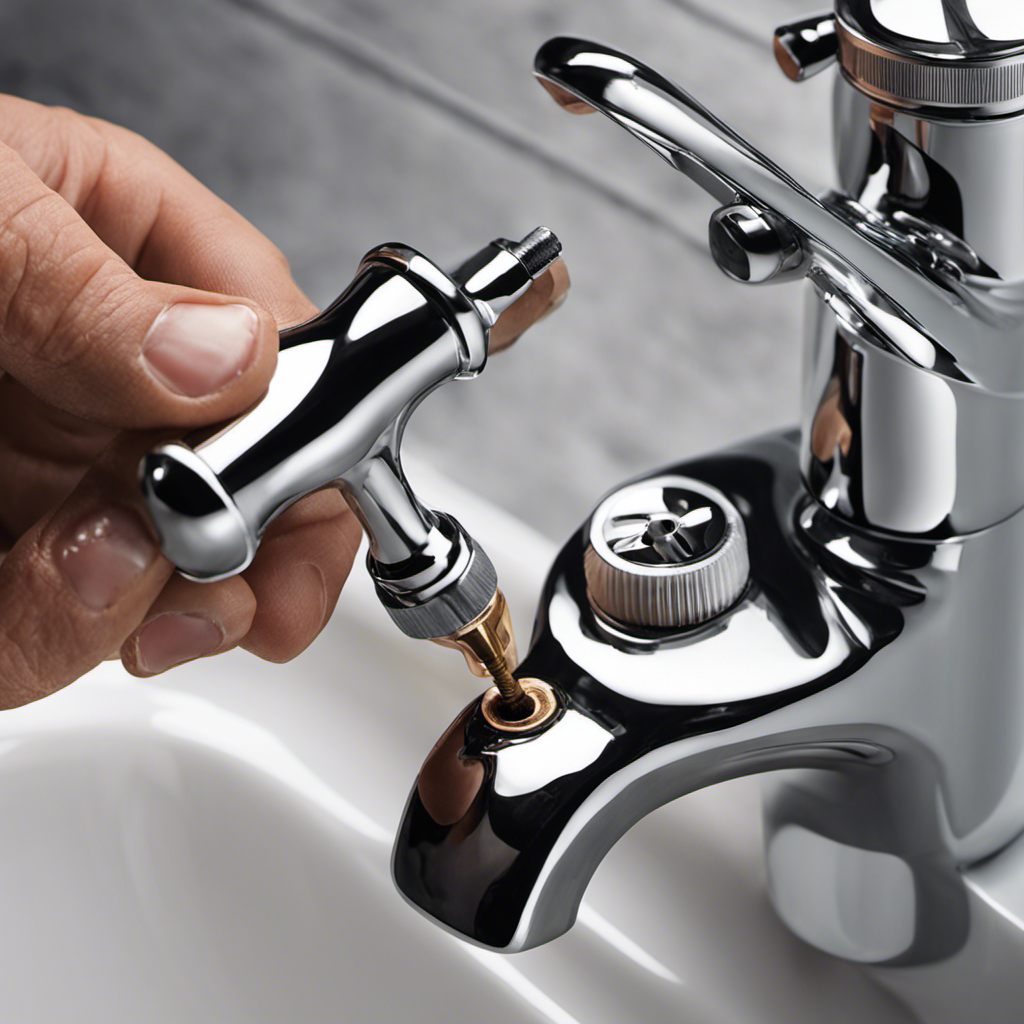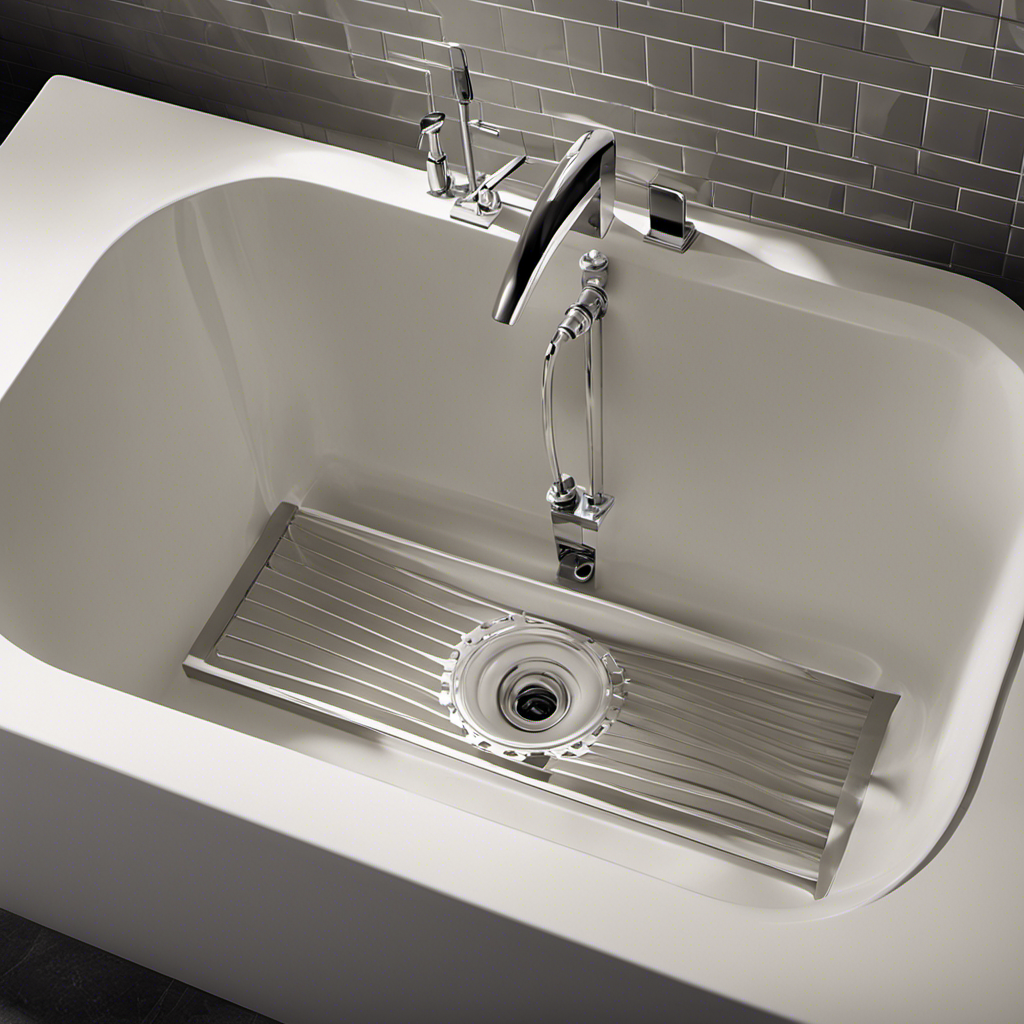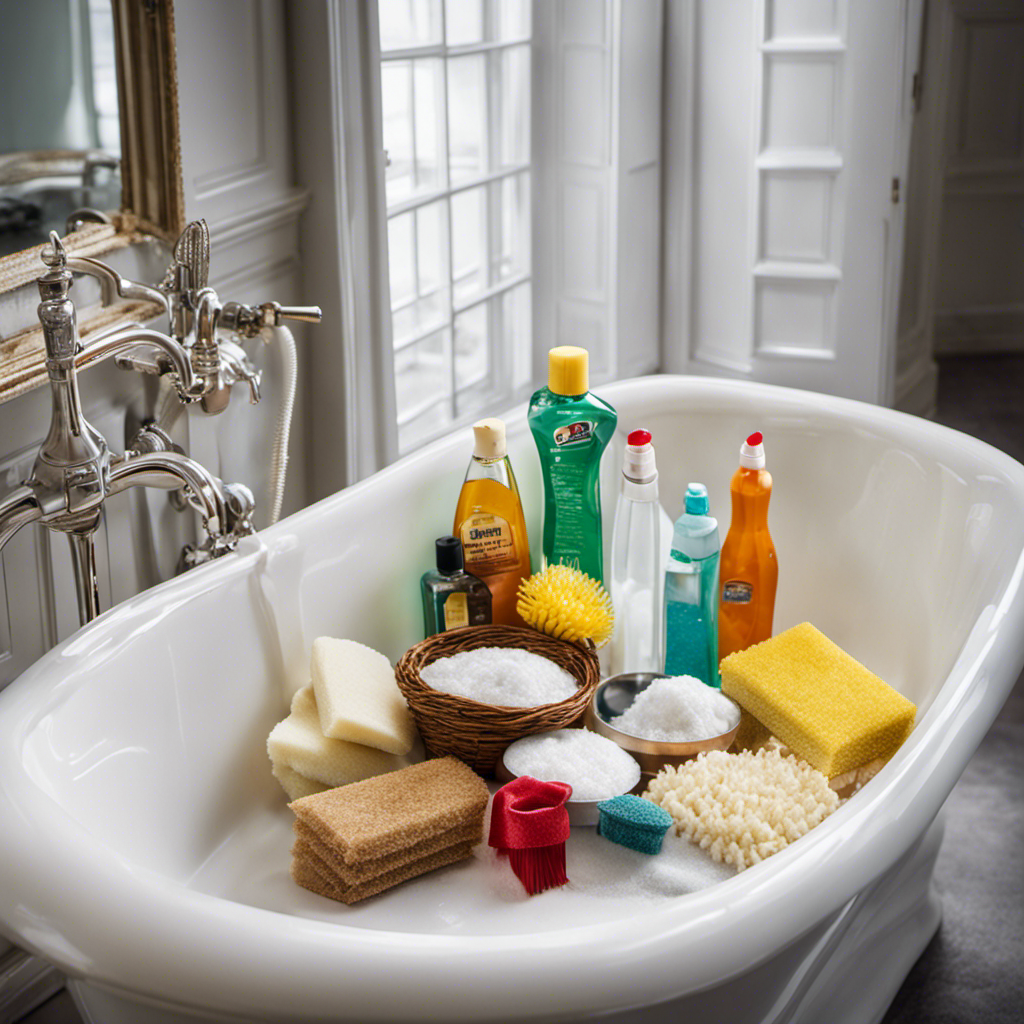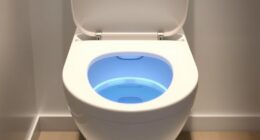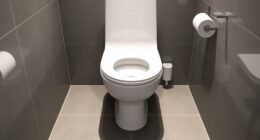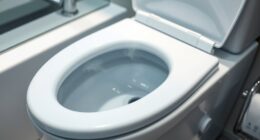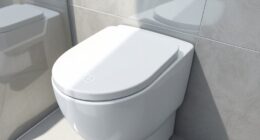Are you tired of dealing with a dirty and grimy baby bathtub? Don’t worry, we’ve got you covered!
In this article, we will show you the best way to clean your baby bathtub and keep it sparkling clean for your little one’s bath time.
You’ll learn the right cleaning products to use, how to prepare the bathtub for cleaning, and the steps to remove soap scum and residue.
Say goodbye to a dirty bathtub and hello to a fresh and sanitary bathing experience for your baby!
Key Takeaways
- Choose gentle and non-toxic cleaning products
- Prioritize safety and the baby’s health
- Regularly clean and maintain the bathtub drain
- Clean the baby bath seat or support with mild detergent and thorough rinsing
Choosing the Right Cleaning Products
When choosing the right cleaning products for your baby bathtub, make sure to look for gentle and non-toxic options. It is important to prioritize your baby’s health and safety by choosing eco-friendly products and avoiding harsh chemicals.
Eco-friendly cleaning products are made from natural ingredients, which are not only gentle on your baby’s sensitive skin but also better for the environment. Look for labels that indicate products are free from harmful chemicals such as phthalates, parabens, and sulfates. These chemicals can irritate your baby’s skin and cause allergies or other health issues.
Opt for plant-based and biodegradable options that are safe for your little one and won’t harm the planet. By choosing eco-friendly products, you can keep your baby bathtub clean and hygienic without compromising on safety.
Preparing the Baby Bathtub for Cleaning
When it comes to cleaning your baby bathtub, it’s important to prioritize safety. Opt for safe cleaning products that are free of harsh chemicals and irritants, ensuring that your baby’s delicate skin is protected.
Additionally, proper drainage maintenance is crucial to prevent clogs and maintain a hygienic environment for your little one. Regularly clearing out any debris or hair from the drain will help to ensure that bath time remains enjoyable and clean.
Safe Cleaning Products
To keep your baby safe, use gentle and non-toxic cleaning products when cleaning the bathtub.
While there are many commercial cleaning products available, it’s important to consider natural alternatives or homemade cleaning solutions that are safe for your little one.
Commercial cleaning products often contain harsh chemicals that can irritate your baby’s delicate skin and respiratory system. Instead, opt for natural alternatives such as vinegar, baking soda, and lemon juice.
These ingredients are not only safe for your baby, but also effective in removing soap scum and mildew. For example, you can create a simple homemade cleaning solution by mixing equal parts vinegar and water in a spray bottle.
Spray the solution onto the bathtub’s surface, let it sit for a few minutes, and then scrub with a soft brush or sponge. Rinse thoroughly with water afterwards.
Proper Drainage Maintenance
Using gentle and non-toxic products is important for maintaining proper drainage in the bathtub. To prevent drainage issues and water buildup, follow these simple steps:
- Regularly clean the drain by removing any hair or debris that may be blocking it.
- Use a vinegar and baking soda solution to unclog and prevent buildup in the pipes.
- Install a drain cover or strainer to catch any larger particles before they go down the drain.
Proper drainage maintenance is crucial in keeping your baby’s bathtub clean and hygienic. By taking these preventive measures, you can ensure that water flows smoothly and efficiently, preventing any potential issues.
Now, let’s move on to the next section, where we will discuss how to remove soap scum and residue from the bathtub.
Removing Soap Scum and Residue
It’s important to regularly remove soap scum and residue from your baby bathtub to keep it clean and hygienic.
Cleaning techniques and homemade remedies can help you achieve this. One effective technique is to mix equal parts of white vinegar and water in a spray bottle. Spray the solution onto the soap scum and let it sit for a few minutes. Then, scrub the area with a soft brush or sponge. Rinse thoroughly with warm water.
Another homemade remedy is to create a paste by mixing baking soda with water. Apply the paste to the soap scum and let it sit for a while before scrubbing and rinsing.
Remember to always dry the bathtub thoroughly after cleaning to prevent mold and mildew growth.
Cleaning the Drain and Plug
If you’ve noticed that your drain is starting to slow down or water is pooling around the plug, it might be time to address the issue of hair clogging.
Removing hair from the drain can be a simple task that you can do yourself, saving you from costly plumber visits.
Additionally, taking preventative measures to avoid clogs in the plug, such as using a drain cover or regular maintenance, can help keep your drains clear and functioning properly.
Removing Hair From Drain
To remove the hair from the drain, you’ll need to grab a pair of disposable gloves. Follow these steps to effectively remove hair clogs from your drain:
-
Start by removing any visible hair on the surface using your gloved hand or a tissue.
-
Use a drain strainer to prevent hair from going down the drain in the first place. This simple device catches hair and debris, allowing you to easily remove them before they cause a clog.
-
For stubborn hair clogs, try using a drain snake or a wire hanger. Insert the snake or hanger into the drain and gently push it through, twisting and turning to catch the hair. Pull the clog out slowly to avoid damaging the pipes.
Preventing Clogs in Plug
Make sure you regularly use a plug strainer to catch any hair or debris and prevent clogs in your drains. This simple step can save you from the hassle of dealing with a clogged drain and the potential water overflow that comes with it. By using a plug strainer, you can easily remove any hair or debris that may have accumulated in your drain, ensuring that water flows smoothly and preventing any blockages. Additionally, using a plug strainer can also help prevent mold growth in your drains. The trapped hair and debris can create a moist environment that is conducive to mold growth. By keeping your drains clean and free of clogs, you can avoid water overflow and prevent the growth of mold in your bathroom.
| Advantages of Using a Plug Strainer | ||
|---|---|---|
| Prevents Clogs | Avoids Water Overflow | Prevents Mold Growth |
| Easy to Use | Cost-effective | Promotes Good Hygiene |
| Durable | Versatile | Eco-friendly |
| Efficient | Time-saving | Low Maintenance |
| Keeps Drains Clean | Reduces Plumbing Issues | Long-lasting |
Scrubbing the Tub Surface
When cleaning the baby bathtub, use a sponge or cloth to scrub the surface gently. Effective scrubbing techniques are crucial to remove any dirt or grime that may have accumulated.
Here are some tips to ensure a thorough clean:
- Start by wetting the sponge or cloth with warm water.
- Apply a small amount of non-toxic cleaning solution to the sponge or directly on the surface.
- Use circular motions to scrub the entire bathtub, paying special attention to areas with stains or residue.
Remember to rinse the bathtub thoroughly after scrubbing to remove any remaining cleaning solution. It’s important to choose non-toxic cleaning solutions to ensure the safety of your baby. Avoid harsh chemicals that may irritate their sensitive skin.
Cleaning the Baby Bath Seat or Support
Using a mild detergent, gently wipe down the baby bath seat or support to remove any dirt or residue. It’s important to keep the bath seat clean to ensure your baby’s safety and comfort during bath time.
Start by filling a basin or sink with warm water and a small amount of mild detergent. Dip a soft cloth or sponge into the soapy water and wring it out to remove excess liquid. Then, carefully wipe down the entire surface of the bath seat, paying extra attention to any crevices or hard-to-reach areas.
Rinse the seat thoroughly with clean water and pat it dry with a clean towel. Additionally, don’t forget to regularly clean the baby bath toys to prevent the buildup of bacteria. Simply wash them with warm soapy water, rinse thoroughly, and let them air dry.
Lastly, to prevent slipping in the baby bathtub, make sure to place a non-slip mat or adhesive strips on the bottom of the tub. These measures will help ensure a safe and enjoyable bath time for your little one.
Dealing With Stains and Mildew
To get rid of stains and mildew, try using a mixture of vinegar and water to wipe down the bath seat or support. The acidity of vinegar helps remove stains and prevents the growth of mildew. Here are some stain removal techniques and mildew prevention tips to keep your baby’s bath seat or support clean:
- Create a cleaning solution by mixing equal parts of vinegar and water.
- Dip a cloth or sponge into the solution and gently scrub the stained areas.
- Rinse the bath seat or support with clean water to remove any residue.
By regularly cleaning and maintaining your baby’s bath seat or support, you can ensure a hygienic bathing experience.
Now, let’s move on to the next step: drying and disinfecting the baby bathtub.
Drying and Disinfecting the Baby Bathtub
To ensure that your bathtub is thoroughly disinfected and dried, you’ll want to follow these simple steps.
After cleaning your baby bathtub, it is important to dry it properly to prevent the growth of bacteria and mildew. Start by using a clean towel or cloth to wipe down the tub and remove any excess water. Pay special attention to the corners and crevices where moisture can accumulate.
Next, consider using a disinfectant to kill any remaining bacteria. There are various disinfectant options available, such as bleach or vinegar solutions. Dilute the disinfectant according to the instructions and apply it to the tub, making sure to cover all surfaces. Allow the disinfectant to sit for the recommended amount of time before rinsing it off with clean water.
Now, your bathtub is disinfected and ready for drying. To effectively dry the tub, open windows or turn on fans to promote air circulation. You can also use a hairdryer on a low heat setting to speed up the drying process.
Once the bathtub is completely dry, you can proceed with regular maintenance and cleaning tips, which will help keep it clean and safe for your baby.
Regular Maintenance and Cleaning Tips
For regular maintenance and cleaning, don’t forget to regularly check for any signs of wear and tear in order to keep your bathtub safe and in good condition. Here are some essential tips to ensure your baby bathtub stays clean and well-maintained:
-
Cleaning Hacks: Use a mild detergent or baby-safe soap to clean the bathtub. Avoid harsh chemicals that may irritate your baby’s sensitive skin.
-
Regular Inspection: Check for any cracks, chips, or loose parts in the bathtub. These can be potential safety hazards and should be repaired or replaced immediately.
-
Preventing Mold and Mildew: After each use, thoroughly rinse and dry the bathtub to prevent the growth of mold and mildew. You can also use a mixture of vinegar and water to remove any stubborn stains or odors.
Frequently Asked Questions
How Often Should I Clean My Baby Bathtub?
You should clean your baby bathtub regularly to maintain hygiene and prevent bacteria growth. Use safe cleaning products and follow best practices, such as scrubbing with a mild detergent and rinsing thoroughly.
Can I Use Bleach to Clean My Baby Bathtub?
Yes, you can use bleach to clean your baby bathtub, but there are also bleach alternatives and natural cleaning solutions that are safer for your little one. Let’s explore the options together.
Is It Safe to Use Vinegar as a Cleaning Solution for My Baby Bathtub?
Yes, it is safe to use vinegar as a cleaning solution for your baby bathtub. Vinegar is a natural alternative to harsh chemicals and is effective at removing soap scum and grime.
What Should I Do if My Baby Bathtub Has Stubborn Stains That Won’t Come Off?
If your baby bathtub has stubborn stains that won’t come off, don’t worry! There are effective stain removal methods you can try. Look for natural alternatives to harsh chemicals for cleaning baby bathtubs.
How Should I Store My Baby Bathtub When Not in Use?
To properly store your baby bathtub when not in use, follow these tips. Make sure it is thoroughly dry before storing it in a clean, dry area. This will help prevent mold from forming and keep it in good condition.
Conclusion
In conclusion, by following these steps, you can ensure that your baby bathtub remains clean and safe for your little one.
Remember, a clean bathtub symbolizes a happy and healthy environment for your baby, free from germs and bacteria.
Regular maintenance and cleaning will not only keep the bathtub in pristine condition but also provide a soothing and enjoyable bathing experience for your little bundle of joy.
So, grab your cleaning products and get started on keeping that baby bathtub sparkling clean!
